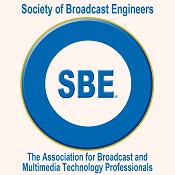
|
|
 CHAPTER 24, Inc., MADISON, WI |
- Home
- Meetings
Schedule - Meeting
Minutes - Chapter
By Laws - Chapter
Officers -
Technical
Documents -
EAS
Info -
Chapter
Archives - Sustaining
Members -
Broadcasters
Clinic - DTV for
Consumers - Links
ARTHUR C. CLARKE: THE FATHER OF SATELLITE COMMUNICATIONSby Neal McLain, CSBEThis story begins in 1945, during the closing months of World War II. At the time, Arthur C. Clarke as an officer in Britain's Royal Air Force, and a member of the British Interplanetary Society. In February of that year, Wireless World, a British technical journal, published a letter written by Clarke under the heading "V2 for Ionospheric Research." This letter suggested the possibility of using rockets, such as the German V2 rockets falling on London at that very moment, for post-war research into the upper atmosphere. This letter also contained the following words:
" ... I would like to close by mentioning a possibility of
the more remote future -- perhaps half a century ahead. An
'artificial satellite' at the correct distance from the earth
would ... remain stationary above the same spot and would be
within optical range of nearly half the earth's surface. Three
repeater stations, 120 degrees apart in the correct orbit, could
give television and microwave coverage to the entire planet."
And so it was that Arthur C. Clarke predicted, in 1945, that by the year 1995 the inhabitants of this planet would have deployed three communications satellites in geostationary orbit.Clarke subsequently expanded this idea, describing it in two articles: • "Extra-Terrestrial Relays," published in the October, 1945 issue of Wireless World. This article developed the idea fully, with rigorous technical analyses of the orbital geometry and the radio communications links. Clarke again suggested that three satellites would be required, and even provided specific locations: 30°E, 150°E, and 90°W. Clarke's original title for this article was "The Future of World Communications," but the editor of Wireless World coined a new word, "extra-terrestrial," and gave the article its published title. As a result of these publications, Clarke is generally recognized as the originator of the concept of the geostationary communications satellite. Among other honors, he was the 1988 recipient of the Marconi International Fellowship "for first specifying in detail the potentialities and technical requirements for the use of geostationary satellites for global communications ..." Yet Clarke never claimed that the geostationary orbit was an original concept. Indeed, in Ascent to Orbit, he goes to some length to disclaim credit: "I have sometimes been credited with the discovery of the stationary orbit itself, which of course is ridiculous. No one could have 'discovered' this, since its existence was perfectly obvious from the time of Newton (indeed, of Kepler!) ..." By the early seventies, Clarke's grand vision was becoming a reality. The feasibility of distributing video programming by satellite had been proven, and governments around the world began launching satellites for domestic television distribution. Satellites appeared at numerous locations throughout the geostationary arc; the number quickly grew beyond the three Clarke originally suggested. By the end 1975, Clarke himself, from his home in Sri Lanka, was able to watch educational programming provided by the government of India -- just 30 years after his famous Wireless World article, not "half a century" later, as he had originally predicted. Clarke is also known as a science fiction writer. Among his works in this genre are: • Earthlight (novel, 1953) • The Nine Billion Names of God (short story, 1955) • 2001: A Space Odyssey (screenplay, with Stanley Kubrick, 1968) • Rendezvous with Rama (novel, 1973) • 2010: Odyssey Two (novel, 1982) • 2061: Odyssey Three (novel, 1987) • 3001: The Final Odyssey (novel, 1997) Clarke is still alive today, living in Colombo, Sri Lanka. He shares his home with a family of pet monkeys and a fixed earth station originally constructed to receive transmissions from ATS-F, the sixth in the series of Applications Technology Satellites. -------------------------------Further Readings:: • Arthur C. Clarke Institute for Modern Technologies, Sri Lanka. Orbits Index Page |